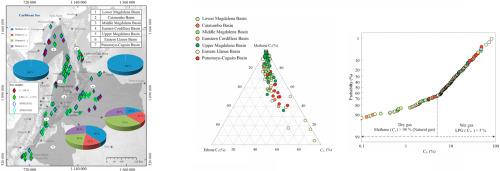Gas geochemistry evaluation of onshore Colombian basins: New insights for natural gas and liquified petroleum gas prospectivity
IF 3.6
引用次数: 0
Abstract
This study examines the molecular and isotopic composition of 193 gas samples collected from oil and gas fields across Colombia's onshore basins with active hydrocarbon production. Comparative analyses were conducted on both isotopic and molecular compositions across the Lower Magdalena Basin (LMB), Middle Magdalena Basin (MMB), Upper Magdalena Basin (UMB), Putumayo Caguán Basin (PUTCAB), Catatumbo Basin (CATB), Eastern Llanos Basin (LLAB), and Eastern Cordillera Basin (ECB). The primary objectives were to classify the gases produced, characterize their origins, assess transformation processes such as biodegradation and migration, and analyze the statistical distribution patterns of their components. This geochemical characterization aims to support the discovery of new reserves for both natural gas (NG) and liquefied petroleum gas (LPG), given Colombia's potential risk of diminished energy self-sufficiency in gas resources. The basins under study produce dry gas, wet gas, and liquefied petroleum gas (LPG/C3+), all associated with oil and gas fields of commercial hydrocarbon production. Notably, the LLAB contains the highest proportions of heavy isotopic carbon and C3+ (LPG) concentrations, whereas LMB is characterized by isotopically lighter methane, indicative of dry gas predominance. Results suggest a predominantly thermogenic origin for the gases studied, generated within the oil and gas windows, with several samples originating from secondary oil cracking, while some samples from LMB display a likely biogenic origin. Additionally, evidence of gas migration and biodegradation was observed in a significant subset of samples. The analysis of statistical distributions and compositional trends reveals a prevalent high methane content, with substantial C2-C5 (C2+) gas concentrations across all basins studied. This composition underscores the potential for both natural gas (NG) and LPG production. The C3+ (LPG) content varies between 1 % and 92 %, with 35 % of the samples containing less than 5 % LPG. High original gas-in-place (OGIP) volumes and substantial LPG content in the Eastern Llanos foothills, encompassing fields such as Cusiana and Cupiagua, highlight the prospective potential of this region. Near-field exploration could further add reserves of both NG and LPG.

哥伦比亚陆上盆地天然气地球化学评价:天然气和液化石油气远景的新见解
该研究分析了从哥伦比亚陆上油气生产活跃盆地的油气田收集的193个天然气样本的分子和同位素组成。对比分析了下马格达莱纳盆地(LMB)、中马格达莱纳盆地(MMB)、上马格达莱纳盆地(UMB)、Putumayo Caguán盆地(PUTCAB)、Catatumbo盆地(CATB)、东Llanos盆地(LLAB)和东Cordillera盆地(ECB)的同位素和分子组成。主要目标是对产生的气体进行分类,确定其来源,评估诸如生物降解和迁移等转化过程,并分析其成分的统计分布模式。考虑到哥伦比亚天然气资源能源自给能力下降的潜在风险,这种地球化学特征的目的是支持天然气(NG)和液化石油气(LPG)新储量的发现。所研究的盆地生产干气、湿气和液化石油气(LPG/C3+),这些盆地都与商业油气生产的油气田有关。值得注意的是,LLAB的重同位素碳和C3+ (LPG)浓度最高,而LMB的特征是同位素较轻的甲烷,表明干气为主。结果表明,所研究的气体主要是在油气窗内产生的热成因,其中一些样品来自二次石油裂解,而LMB的一些样品则可能是生物成因。此外,在大量样品中观察到气体迁移和生物降解的证据。统计分布和组成趋势分析表明,甲烷含量普遍较高,且所有研究盆地都含有大量的C2- c5 (C2+)气体。这种结构强调了天然气(NG)和液化石油气(LPG)生产的潜力。C3+ (LPG)含量在1%到92%之间,35%的样品中LPG含量低于5%。在东Llanos山麓地区,包括Cusiana和Cupiagua等油田,高原始天然气储量(OGIP)和大量液化石油气含量突出了该地区的前景潜力。近场勘探可以进一步增加天然气和液化石油气的储量。
本文章由计算机程序翻译,如有差异,请以英文原文为准。
求助全文
约1分钟内获得全文
求助全文

 求助内容:
求助内容: 应助结果提醒方式:
应助结果提醒方式:


